Want to know more about us
Various destinations around the world. With our knowledge and expertise in the travel industry, we ensure that all aspects of your trip are tailored to your preferences and budget and make it an experience of a lifetime.
We prefer to have a minimum of 2 clients and a maximum of 15 on each team because it can be better controlled, delivering good services and good taking care of clients. But if anybody wants to do a private trek on his/her own, we can organize such an expedition as well.
YES, private trip available, we also offer a trip for family members, office staff team, and team build from friend-to-friend. For this kind of trek & climb, the itinerary can be re-arranged and the date will be customized.
To participate in our expedition, either an experience required or it depends on the difficulty of the climbing trip. We have clearly explained it on the experience and fitness section of each expedition trip. Please have a look at that and still if you do not satisfy yourself or have more questions, please inquiry us.
We have a team of Government licensed Sherpa Guides who can speak English and French fluently, who is best known for this industry due to their multiple times Mt. Everest and other 8000-meter peak summiteers. Very experienced, technically and physically fit, well known about the first aid, local cultures, and traditions, and always very caring to the clients.
We also have a bunch of good English speaking assistant Sherpa climbing guides, who are also called “Climbing Sherpa”. Multiple times Mt. Everest and other 8000m summiteers, good with first aid kit, local cultures, trained and always helpful to the clients. Our normal ratio of assistant guides is 1:1. This means, 1 Sherpa for 1 climbing members, and the ratio of the climbing Sherpa also depends on the difficulty of the mountain. Please have a look at the service included section of the particular expedition trip. Many of the trekking agencies offer very fewer ratios of trek assistant guide to making the cost very cheap, but this can bring a lot of risks on the trek and maximum chances of not receiving required assistant by the clients in the right place and on right time.
For the 7000m expedition 1:2.This means 1 Sherpa for 2 Climbing members.
Many reasons might make a guided expedition worthwhile even for experienced climbers. Sherpas are well known for mountaineering all over the world and they are the real heroes of the big mountains’ expedition especially for 7,000-meter and 8,000-meter mountains. If you have good and experienced Sherpa guide then your successful summit is guaranteed and we are committed to providing well-experienced Sherpas for our expeditions. On guided expedition, you will be always good taken care of in terms of your local transport, confirming hotels, required flight, reliable logistic arrangement, checking the number of evening snacks, ensuring reliable support, overall transports, permits, visas, team members, gear, etc. These will save your time and energy for the part that matters – working on achieving your goal. The high levels of support and experience aim to give you the best possible opportunity to succeed, a high level of risk management, and the Churen Himal Treks’ Sherpa Guides and staffs are there for YOU!
YES, we can provide limited services as well, as explained above. We have options of base camp logistics, advance base camp logistics, where we supply your required logistic services only. For TIBET expeditions, we have options like an advance base camp logistic and full board; whereas for Nepal expeditions, we have base camp logistic and full board logistic. Therefore, you have to tell us clearly about your requirements.
Teahouse Trek
Types and quality of the meals also depend on trekking areas. Everest, Annapurna & Langtang areas offer various type of meals whereas Kanchenjunga, Manaslu & Mustang areas offer fewer varieties of meals often Nepali meals “Dhal Bhat” which is Rice, curries & Lentil, fried rice, noodles, etc. In Everest & Annapurna areas, you will get a menu to choose your meals or some examples given below:
Breakfast
Egg, porridge, cereal, toast with jam and honey, pancake, etc.
Lunch
Nepali traditional meals “Dhal Bhat with curry”, spring roll with some additional French fries, rice with chicken curry Indian style or some time we can have packed lunch, etc.
Dinner
Generally start with soup (vegetable, mushroom, chicken, etc.).
The main meal is one of the many Asian or European dishes and the dessert will be apple pie, mix fruit, etc.
(We are very careful about using the lodges throughout the trek; therefore we have very selected lodges on Everest trek, where we assured the quality and hygienic meals and good accommodation PLUS, during camping at base camp and higher camps, we are committed to providing the best meals, best tents, and complete logistics.)
Camping Trek
Our cook and kitchen staff will prepare the best, hygienic and quality meals as much as possible. And either we use chemicals or boil the fresh vegetables before serving them. We believe in quality meals so we are committed to it.
Generally, we provide 3 meals a day with tea/coffee, so snacks order will be extra to be paid by the clients, not from our package
We normally use The North Face tent and provide either single or twin shared tents based on requirements with form sleeping mattress to each client. And sharing basis tents for the higher camps.
YES, we advise our climber to bring a personal first aid box based on your requirements. And we also organize and carry a group first aid kit, and if you run out or don’t have the required medicines, you can have access to our medical kit and it can also use for our local staff.
Despite the best precautions, people do sometimes fall ill, develop symptoms of AMS. Our guide will manage your care keeping in mind what’s best for you and the rest of the group. Our precautions include pre-advice to aware of AMS, first aid qualifications and kits, emergency communications, evacuation plans, your travel insurance cover, and our pre-preparation and medical advisors
Our most of the trek & climbing trips go to the remote area of Himalayas; therefore for your safe travel, insurance is mandatory. You must have to obtain maximum coverage travel insurance which must cover emergency evacuation, medical treatment expenses, and repatriation. And check either your policy covers up to the height that you are going to ascent? And climb with using the climbing gears, rope? Please have a look travel insurance
There are two ways to obtain a Nepal entry visa, either you can apply at Nepal visa Consulate office in your town or nearest town to you, otherwise, you obtain it on your arrival in Kathmandu Tribhuban Int’l airport. Regarding the visa fee, you need USD, Euro or AUD cash (preferably the right money) and a passport photo, a completed application form (available in the arrivals hall) and need to go to the counter labelled for visitors without a visa. An entry visa costs (currently) USD 125, which is valid for 90 days. For shorter trips, a 30-day visa currently costs USD 50 and 15 days visa fee is US$ 30 (if your trip is not more than 15 days so get 15 days visa and pay less).
Unless you don’t mind communicate, local sim (Ncell) does work pretty good while on a trek as well. You can buy a local sim card very easily at most of the cybercafé in town or better on your arrival day at KTM airport, you can buy it free of cost at the airport, just go with your copy of passport and a photograph.
AMS, Acute Mountain Sickness is the body reacting to the stress of high altitude. It is a concern for trekkers in the high altitude trekking. As per our experiences, it can be seen above 3000m of altitude. Exposure to high altitude can lead to several ‘normal’ physiological reactions as well as mild to extremely serious illness and even to death. We take the risk of AMS seriously and work hard to avoid and minimize it. We monitor our trekkers and climbers in how to take care of themselves and each other and what to look out for. Our treks are designed with relatively slow acclimatization schedules including some rest days with hiking days. And we have medications and several management strategies in place should they be required and the very mild headache on and above 4000m is considered as normal but you have to always care and consult with your trek guide in such cases.
We advise to consult with your doctor and get approval from the doctor for the fitness for the trek and send it to us. If you are not fit then better you can look for other options like an easy or moderate trek or some tours
This will be as per booking terms & conditions but normally NO refund.
We can provide you with a complete list of gears upon your booking of the trip but generally climbing boot, crampon, harness set, ice axe, good trekking/hiking boot, Sleeping bag, down jacket, daypack, layers of breathable clothing for day and night, etc.
If you are doing one of our 6,000m expedition then you can hire some of the climbing gears in KTM trekking and gears shop, but especially for 7,000m and 8,000m expeditions, we strongly suggest bringing well-reputed branding gears in good condition, brands like Millet, La Sportiva, Mountain Hardware, etc. and this stuff are not available on hire.
Tipping is a kind of motivation factor for our local staff and on our treks & expedition. The local people appreciate being rewarded directly by the clients for doing a good job. This encourages them to work hard and perform their duties to a high level of quality. Depending on several clients in the team, we advice appropriate tips in trip notes and tips are sometimes best administered by the Sardar, Cook and sometimes with assistance from the Trek & Expedition Leader.
We prefer to have a minimum of 2 clients and a maximum of 15 on each team because it can be better controlled, delivering good services and good taking care of clients. But if anybody wants to do a private trek on his/her own, we can organize such peak climbing as well.
YES, private peak climbing available, we also offer trips like honeymoon trip, family members, office staff team, friend-to-friend climbing trip, etc. For this kind of trek & climb, the itinerary can be re-arranged and the date will be customized
To participate on our peak climbing trip, previous mountaineering experience is not mandatory but you need to be physically fit and mentally prepared. If you do one of our challenging treks would be much more helpful to you and also, you must have to go through the training session as suggested based on the trip.
We have a team of Government licensed holder guide who can speak English and French fluently, who is best known for this industry. Very experienced, technically and physically fit, certified with the Mountaineering training, well known about the first aid, local cultures, and traditions, and always very caring to the clients.
We also have a bunch of good English speaking assistant guides, who are also called “Climbing Sherpa”. They are very knowledgeable about first aid kit, local cultures, well trained and always helpful to the clients. And our normal ratio of assistant guides is 1:3. Which means, 1 Climbing Sherpa for 3 climbing members during the climbing. Many of the trekking agencies offer very fewer ratios of a Climbing sherpa to making the cost very cheap, but this can bring a lot of risks on the climbing the peak and maximum chances of not receiving required assistant by the clients in the right place and on right time.
Our main goal is a successful and safe trip. Therefore we will have porters, horses, and yaks to carry the heavy loads. You have to pack most of your gears in the duffle bag and that will be carried by porters/yak and what you have to carry is your daypack, recommended 45L to 55L with about 7 kg including your water for the day. If the trek is camping, then all camping equipment, kitchen equipment, and food will be carried by the porters/yaks and you can walk with the above-recommended daypack.
GEARS, we often separate them into 2 parts, Trekking gears, and climbing gears. Trekking gears maximum allowed weight per client is 12 kg in a duffle bag.
Whereas climbing gears such as boot, crampon, jumar, ice axe, etc., will be collected from every client and pack separately in a barrel or hard duffle bag because sometimes, we have to send climbing gears straight to the base camp rather take on trek unnecessarily.
The porters will carry duffle bag and daypack will be carried by the trekkers himself or herself
All the main heavy gears will be packed in the duffle bag including sleeping bag, down jacket, etc. you can pack only very personal items in the daypack, such as waterproof jacket and pant, a warm jacket, thin a pair of gloves, water bottles, extra running shoes, a top to the bottom complete set of clothes to change with the wet cloths, sun cream, and some very personal items.
Unless you don’t mind communicate, local sim (Ncell) does work pretty good while on a trek as well. You can buy a local sim card very easily at most of the cybercafé in town or better on your arrival day at KTM airport, you can buy it free of cost in the airport, just go with your copy of passport and a photograph.
Please don’t expect toilet facility as at your home and if you are doing one of the climbing trip combined with teahouse trek, it depends where you are going for a trek like if you are going in Everest area, pretty good toilet facility is an available, normally common toilet on each floor. But if you are going to remote areas like the Kanchenjunga area, the toilet will be fixed outside of the main building and made by wooden. We advise always to keep your personal toilet paper during the trek. On the camping trek, we provide toilet tent and Sherpa staff will put this tent away from the track, camp and water resources.
Teahouse Trek
Types and quality of the meals also depend on trekking areas. Everest, Annapurna & Langtang areas offer various types of meals whereas Kanchenjunga, Manaslu & Mustang areas offer fewer varieties of meals often Nepali meals “Dhal Bhat” which is Rice, curries & Lentil, fried rice, noodles, etc. In Everest & Annapurna areas, you will get a menu to choose your meals or some examples given below:
Breakfast
Egg, porridge, cereal, toast with jam and honey, pancake, etc.
Lunch
Nepali traditional meals “Dhal Bhat with curry”, spring roll with some additional French fries, rice with chicken curry Indian style or some time we can have packed lunch, etc.
Dinner
generally start with soup (vegetable, mushroom, chicken, etc.). The main meal is one of the many Asian or European dishes and the dessert will be apple pie, mix fruit, etc.
(We are very careful about using the lodges throughout the trek; therefore we have very selected lodges, where we assured that, quality and hygienic meals)
Camping Trek
Our cook and kitchen staff will prepare the best, hygienic and quality meals as much as possible. And either we use chemicals or boil the fresh vegetables before serving them. We believe in quality meals so we are committed to it.
Generally, we provide 3 meals a day with tea/coffee, so snacks order will be extra to be paid by the clients, not from our package.
On tea house trek, it is always twin shared room throughout the trek. You must have to prepare your personal sleeping bag with liner and inflatable mattresses. The beds in the lodges are wooden with few inches of form mattress and clean Blankets. But if you are going on a trek where lodges are just trying to develop itself, then often there will be a lower quality of accommodations and in some places, tent with your personal sleeping bag and mat might require.
(We are very careful about using the lodges throughout the trek; therefore we have very selected lodges, where we can get nicer and better accommodation)
On camping trek, We normally use Ozark tent and provide either single or twin shared tents with form mattress to each client.
On our teahouse based trek, we have been using SteriPen or some liquid to purify the tap water and make it safe for drinking. SteriPEN harnesses the brilliant power of ultraviolet light to make water safe to drink. It’s the same technology used by leading bottled water manufacturers as well as major cities in the U.S., Europe, and Asia to purify. Just for in case, we keep some water purification tablets as well and we advise all our trekkers to keep some tables for your personal use in case if we run out. But whereas on our camping trek, we provide boiled water during the trekking period. We strongly advise all our clients, don’t drink water directly from the tap during your stay in the cities, please buy bottle water.
YES, we advise our trekkers to bring your personal first aid kit based on your requirements. The company will also send a group first aid kit with the guide in case if you run out or don’t have the required medicines, and you can have access to our medical kit and it can also use for our local staff.
Despite the best precautions, people do sometimes fall ill, develop symptoms of AMS. Our guide will manage your care keeping in mind what’s best for you and the rest of the group. Our precautions include pre-advice to aware of AMS, first aid qualifications and kits, emergency communications, evacuation plans, your travel insurance cover, and our pre-preparation and medical advisors.
Most of the treks are challenging and takes you to the remote area of Himalayas. Therefore for your safe travel, insurance is mandatory; you must have to obtain maximum coverage travel insurance which must covers, emergency evacuation, medical treatment expenses, and repatriation. And check either your policy covers up to the height that you are going to ascent? And climb with using the climbing gears, rope? Please have a look at travel insurance.
There are two ways to obtain a Nepal entry visa, either you can apply at Nepal visa Consulate office in your town or nearest town to you, otherwise, you obtain it on your arrival in Kathmandu Tribhuban Int’l airport. Regarding the visa fee, you need USD, Euro or AUD cash (preferably the right money) and a passport photo, a completed application form (available in the arrivals hall) and need to go to the counter labelled for visitors without a visa. An entry visa costs (currently) USD $125, which is valid for 90 days. For shorter trips, a 30-day visa currently costs $50 USD and 15 days visa fee is US$ 30 (if your trip is not more than 15 days so get 15 days visa and pay less).
AMS, Acute Mountain Sickness is the body reacting to the stress of high altitude. It is a concern for trekkers in the high altitude trekking. As per our experiences, it can be seen above 3000m of altitude. Exposure to high altitude can lead to a number of ‘normal’ physiological reactions as well as mild to extremely serious illness and even to death. We take the risk of AMS seriously and work hard to avoid and minimize it. We monitor our trekkers and climbers in how to take care of themselves and each other and what to look out for. Our treks are designed with relatively slow acclimatization schedules including some rest days with hiking days. And we have medications and a number of management strategies in place should they be required and the very mild headache on and above 4000m is considered normal but always you have to careful and consult with your trek guide in such cases.
We advise to consult with your doctor and get approval from the doctor for the fitness for the trek and send it to us. If you are not fit then better you can look for other options like an easy or moderate trek or some tours.
This will be as per booking terms & condition but normally NO refund
We can provide you with a complete list of gears upon your booking of the trip but generally plastic mountaineering boot, crampon, harness, ice axe, good trekking/hiking boot, daypack, layers of breathable clothing for day and night, trekking pole, etc.
YES, most of the climbing gears are available on hire in KTM including plastic mountaineering boot, crampon, ice axe, etc. If you want to hire the plastic boot, you must have to inform us about your foot size in advance so that we can get a good size boot for you. Sometime during the peak season, it’s difficult to get the right size boot.
Tipping is a kind of motivation factor for our local staff and on our treks & expedition. The local people really appreciate being rewarded directly by the clients for doing a good job. This encourages them to work hard and perform their duties to a high level of quality. Depending on the number of clients in the team, we advice appropriate tips in trip notes and tips are sometimes best administered by the Sardar, Cook and some time with assistance from the Trek & Expedition Leader.
We prefer to have a minimum of 2 clients and a maximum of 15 on each team because it can be better controlled, delivering good services and good taking care of clients. But if anybody wants to do the private trek on his/her own, we can organize such trek as well.
YES, private trip available and we also offer a trip for family members, office staff team, friend-to-friend team, etc. For this kind of trek & climb, the itinerary can be re-arranged and the date will be customized.
To participate in any of our trekking trips, previous trekking experience is not mandatory but you need to be physically fit and mentally prepared specially to participate in our challenging and tough trekking trips. And also, you must have to go through the training session as suggested based on the trip.
Our trekking trip Package is descriptive about the difficulty level of the given trek -you can get more idea about the fitness requirements.
We have a bunch of Government licensed holder very good English speaking and French-speaking, who are best known for this industry, very experienced, trained, well known about the first aid kit, local cultures and traditions and always very caring to the clients.
We also have a bunch of government-licensed holder good English speaking and French-speaking trek assistant guides, who are also called “Trek Sherpa”. They are also good at first aid, local cultures, trained and always helpful to the clients. And our normal ratio of the trek assistant guide is 1:4. Which means 1 trekking sherpa for 4 trekkers. Many of the trekking agencies offer very fewer ratios of trek assistant guide to bring their cost down, but this brings a lot of risks on the trek and maximum chances of not receiving required assistant by the clients, in the right place and right time.
The number of porters completely depends on the type of trek, either tea house or camping? If the trek is a teahouse, our standard ratio of porters is 1:2 means 1 porter carries 2 trekkers luggage/duffle bag. But if the trek is camping, it’s difficult to predict the number of porters and it often depends on the number of trekking days and pax in the team. But we always hire enough number of porters on each trek.
Our main goal is a successful and safe trip; therefore we will have porters, horses, and yaks to carry the heavy loads. On the teahouse trek, you have to pack your most of the trek gears in the duffle bag and that will be carried by porter/yak and what you have to carry is your daypack, recommended 30L to 40L with about 5 -7 kg including your water for the day. If the trek is camping then all camping, kitchen equipment, and food will be carried by the porters/yaks, and you can walk with an above-recommended daypack.
For our all-trekking trips, the maximum allowed weight per client is 12 kg on the duffle bag and 5kg on a day pack. Most of the domestic flight to the mountain region allows only (12+5)kg per/person as luggage.
The porters will carry duffle bag while the daypack will be carried by the trekkers himself or herself.
All the main heavy gears will be packed in the duffle bag including sleeping bag, down jacket, etc. you can pack only very personal items in the daypack, such as waterproof jacket and pant, a warm jacket, thin a pair of gloves, water bottles, extra running shoes, a top to the bottom complete set of clothes to change with the wet cloths, sun cream, and some very personal items.
Unless you don’t mind communicate, local sim (Ncell) does work pretty good while on the trek as well. You can buy a local sim card very easily at most of the cybercafé in town or better on your arrival day at KTM airport, you can buy it free of cost in the airport, just go with your copy of passport and a photograph.
Please don’t expect toilet facility as at your home and always keep your toilet papers with you during the trek. On the teahouse trek, it depends where you are going for a trek like if you are going in the Everest area, a pretty good toilet facility is an available, normally common toilet in each building floor. But if you are going to remote areas like the Kanchenjunga area, the toilet will be fixed outside of the main building and made out of wood. On the camping trek, we provide toilet tent and Sherpa staff will put this tent away from the track, camp and water resources.
Teahouse Trek
Types and quality of the meals also depend on trekking areas. Everest, Annapurna & Langtang areas offer various types of meals whereas Kanchenjunga, Manaslu & Mustang areas offer fewer varieties of meals often Nepali meals “Dhal Bhat” which is Rice, Curries & Lentil, fried rice, noodles, etc. In Everest & Annapurna areas, you will get a menu to choose your meals or some examples given below
Breakfast
Egg, porridge, cereal, toast with jam and honey, pancake, etc.
Lunch
Nepali traditional meals “Dhal Bhat with curry”, spring roll with some additional French fries, rice with chicken curry Indian style or some time we can have packed lunch, etc.
Dinner
Generally start with soup (vegetable, mushroom, chicken, etc.).
The main meal is one of the many Asian or European dishes and the dessert will be apple pie, mix fruit, etc.
(We are very careful about using the lodges throughout the trek; therefore we have very selected lodges, where we assured that, quality and hygienic meals)
Camping Trek
On tea house trek, it is always twin shared room throughout the trek. You must have to prepare your personal sleeping bag with liner and inflatable mattresses. The beds in the lodges are wooden with few inches of form mattress and clean Blankets. But if you are going on a trek where lodges are just trying to develop itself, then often there will be a lower quality of accommodations and in some places, tent with your personal sleeping bag and mat might require.
(We are very careful about using the lodges throughout the trek; therefore we have very selected lodges, where we can get nicer and better accommodation)
On camping trek, We normally use Ozark tent and provide either single or twin shared tents with form mattress to each client.
We normally use north face tent and provide either single or twin shared tents with form mattress to each client.
On our teahouse based trek, we have been using SteriPen or some liquid to purify the tap water and make it safe for drinking. SteriPEN harnesses the brilliant power of ultraviolet light to make water safe to drink. It’s the same technology used by leading bottled water manufacturers as well as major cities in the U.S., Europe, and Asia to purify. Just for in case, we keep some water purification tablets as well and we advise all our trekkers to keep some tables for your personal use in case if we run out. But whereas on our camping trek, we provide boiled water during the trekking period. We strongly advise all our clients, don’t drink water directly from the tap during your stay in the cities, please buy bottle water.
YES, we advise our trekkers to bring your personal first aid kit based on your requirements. The company will also send a group first aid kit with the guide in case if you run out or don’t have the required medicines, and you can have access to our medical kit and it can also use for our local staff.
Despite the best precautions, people do sometimes fall ill, develop symptoms of AMS. Our guide will manage your care keeping in mind what’s best for you and the rest of the group. Our precautions include pre-advice to aware of AMS, first aid qualifications and kits, emergency communications, evacuation plans, your travel insurance cover, and our pre-preparation and medical advisors.
Most of the treks are challenging and takes you to the remote area of Himalayas. Therefore for your safe travel, insurance is mandatory; you must have to obtain maximum coverage travel insurance which must covers, emergency evacuation, medical treatment expenses, and repatriation. And check either your policy covers up to the height that you are going to ascent? And climb with using the climbing gears, rope? Please have a look at travel insurance.
There are two ways to obtain a Nepal entry visa, either you can apply at Nepal visa Consulate office in your town or nearest town to you, otherwise, you obtain it on your arrival in Kathmandu Tribhuban Int’l airport. Regarding the visa fee, you need USD, Euro or AUD cash (preferably the right money) and a passport photo, a completed application form (available in the arrivals hall) and need to go to the counter labelled for visitors without a visa. An entry visa costs (currently) USD $125, which is valid for 90 days. For shorter trips, a 30-day visa currently costs $50 USD and 15 days visa fee is US$ 30 (if your trip is not more than 15 days so get 15 days visa and pay less).
AMS, Acute Mountain Sickness is the body reacting to the stress of high altitude. It is a concern for trekkers in the high altitude trekking. As per our experiences, it can be seen above 3000m of altitude. Exposure to high altitude can lead to a number of ‘normal’ physiological reactions as well as mild to extremely serious illness and even to death. We take the risk of AMS seriously and work hard to avoid and minimize it. We monitor our trekkers and climbers in how to take care of themselves and each other and what to look out for. Our treks are designed with relatively slow acclimatization schedules including some rest days with hiking days. And we have medications and a number of management strategies in place should they be required and the very mild headache on and above 4000m is considered normal but always you have to careful and consult with your trek guide in such cases.
We advise to consult with your doctor and get approval from the doctor for the fitness for the trek and send it to us. If you are not fit then better you can look for other options like an easy or moderate trek or some tours.
This will be as per booking terms & condition but normally NO refund
We can provide you with a complete list of gears upon your booking of the trip but generally plastic mountaineering boot, crampon, harness, ice axe, good trekking/hiking boot, daypack, layers of breathable clothing for day and night, trekking pole, etc.
Tipping is a kind of motivation factor for our local staff and on our treks & expedition. The local people really appreciate being rewarded directly by the clients for doing a good job. This encourages them to work hard and perform their duties to a high level of quality. Depending on the number of clients in the team, we advice appropriate tips in trip notes and tips are sometimes best administered by the Sardar, Cook and some time with assistance from the Trek & Expedition Leader.
Chat with us

Explore, Experience, Embrace
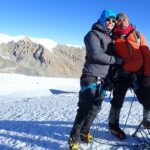
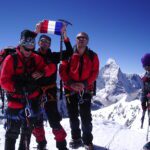
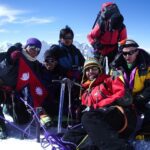
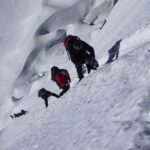
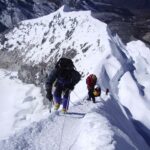
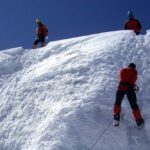
Pure Gurung
+33623450636
Sunil Pokhrel
+41786215571
info@bluemarbleadventures.com